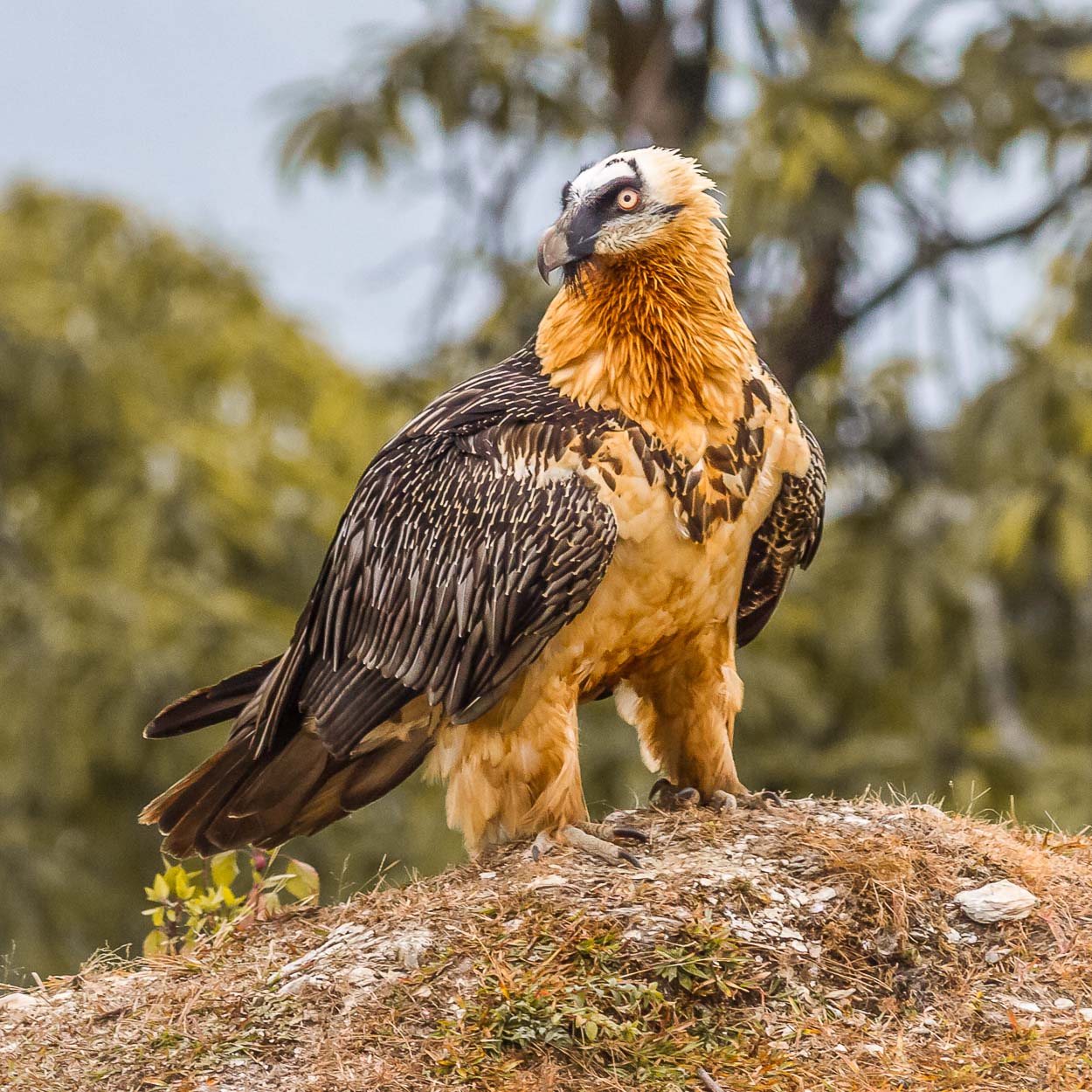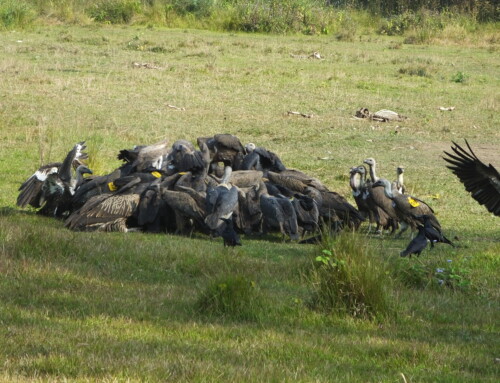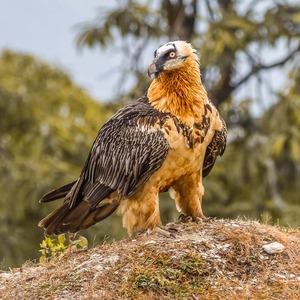 LINKED PAPER
LINKED PAPER
Global range dynamics of the Bearded Vulture (Gypaetus barbatus) from the Last Glacial Maxima to climate change scenarios. Subedi, T.R., Peréz-García, J.M., Gurung, S., Baral, H.S., Virani, M.Z., Sah, S.A. and Anadón, J.D. 2022 Ibis. doi: 10.1111/ibi.13149 VIEW
The Bearded Vulture (Gypaetus barbatus) is a mountain specialist which is distributed across the high elevational ranges of Eurasia and Africa. Over the last three generations (53.4 years), its population has declined across most of the distribution range. As a result, in 2014 the Bearded Vulture was classified as a globally near-threatened species. It is believed that the population declines are associated with the global range contraction in the last century mainly due to unintentional poisoning and direct persecution (Botha et al. 2017, Margalida et al. 2008). Despite its declining status and high habitat specialization, little is known about how climate change is impacting the distribution of suitable habitat, or about global past range dynamics of the species.
To understand the impact of climate change on the global ranges of Bearded Vulture, the current distribution of the Bearded Vulture throughout its entire range was modelled and projected throughout the ranges of Last Glacial Maxima (LGM, 21,000 years ago), Mid-Holocene (MH, 6,000 years ago) and future distribution under 2070s climate change scenarios.
The models were developed in MaxEnt software (Phillips et al. 2004, 2006, Phillips & Dudík 2008) using the species occurrence points collected from various sources (field survey, GPS tracking, eBird, GBIF and grey literature reports) and bioclimatic variables were collated from WorldClim (https://worldclim.org; Hijmans et al. 2005). Two topographic variables (ruggedness and slope) were also used in the model as these have been identified as important variables for the distribution of Bearded Vulture (Donázar et al. 1993).
In the models, three environmental variables (ruggedness, temperature seasonality and mean diurnal temperature range) were key when predicting the distribution of the Bearded Vulture. The model showed 19.29 million km2 of suitable area for the Bearded Vulture over its entire global range under the current climatic scenario (Fig 1). At the continental scale, Asia holds the largest suitable area (67.7%) followed by Africa (20.9%) and Europe (11.4%). Four countries (China, Iran, Russia and Mongolia) hold 44.1% of the suitable habitat with China alone holding more than one quarter (26.9%) of suitable habitats. Between LGM to the MH period, the suitable habitat reduced by 12.2%, followed by 6.3% habitat gain between MH to present scenarios.
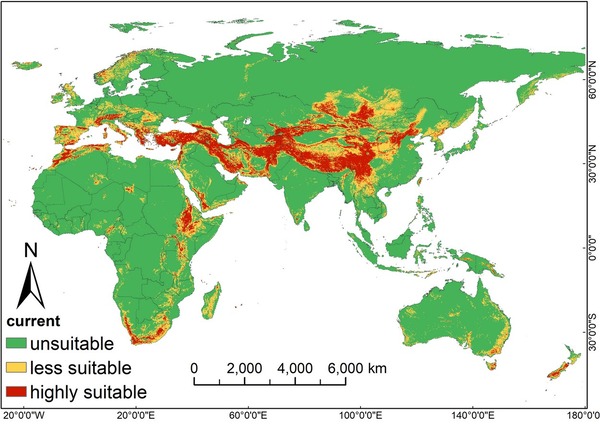
Figure 1 Habitat suitability of Bearded Vulture (Gypaetus barbatus) under the current climatic scenario.
The projection for 2070s has shown the overall reduction of suitable habitat by 15% as compared to present climatic scenarios. The highest loss of habitat was predicted in Africa (34.1%) followed by Asia (9.6%) and then Europe (7.9%, Fig 2). The projection showed the expansion of suitable habitat on more northern latitudes for 2070, mostly in Russia and China, that does not compensate for the range contraction on more southern latitudes, particularly in Africa (34% loss in Africa), resulting in a global loss of 15% of suitable habitat.
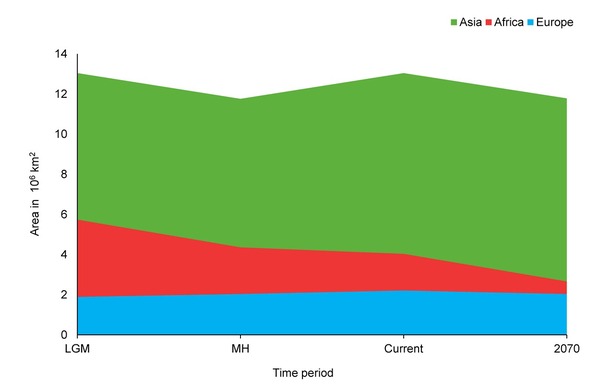
Figure 2 Systematic representation for the visualization of the habitat evolution/changes of Bearded Vulture (Gypaetus barbatus) range distribution over different climatic scenarios among continents. LGM = Last Glacial Maximum, MH = Mid-Holocene.
These models are important to understand the past and future range dynamics of the Bearded Vulture, thus framing current knowledge of the species regarding its ecology and conservation with a wider biogeographical context. Knowledge of the spatial distribution of habitats and the expected changes due to climate change may aid the planning process of effective long-term conservation measures. These include the prioritisation of conservation actions particularly those that aim to reduce non-natural sources of mortality or, in extreme cases, the design of reintroduction programmes.
These fine scale predictions of habitat contraction due to climate change will assist in identifying current proportions of the range that might be particularly vulnerable in coming years. For example, African populations and the more thermic areas in Asia are the most impacted areas, and should be at the forefront of future monitoring and conservation efforts. This work yields to date, the most refined habitat suitability map of the species for the present time which will be also of interest from a conservation standpoint. In particular, it reveals that there is barely any public information on some of the largest areas of continuous high-quality habitat (Tibet, Hindu-Kush, Zagros Mountains) and thus they should be the focus of future monitoring efforts.
References
Botha, A., Andevski, J., Bowden, C., Gudka, M., Safford, R., Tavares, J. & Williams, N. 2017. Multi-species Action Plan to Conserve African-Eurasian Vultures, CMS Raptors MOU Technical Publication No. 4, Coordinating Unit of the CMS Raptors MOU, Abu Dhabi, United Arab Emirates VIEW
Donázar, J.A., Hiraldo, F. & Bustamante, J. 1993. Factors influencing nest site selection, breeding density and breeding success in the bearded vulture (Gypaetus barbatus). Journal of Applied Ecology 30: 504-514 VIEW
Margalida, A., Heredia, R., Razin, M. & Hernández, M. 2008. Sources of variation in mortality of the Bearded Vulture Gypaetus barbatus in Europe. Bird Conservation International 18: 1-10. VIEW
Phillips, S.J. & Dudík, M. 2008. Modeling of species distributions with Maxent: new extensions and a comprehensive evaluation. Ecography 31: 161-175. VIEW
Phillips, S.J., Anderson, R.P. & Schapire, R.E. 2006. Maximum entropy modeling of species geographic distributions. Ecological Modelling 190: 231-259 VIEW
Phillips, S.J., Dudík, M. & Schapire, R.E. 2004. A maximum entropy approach to species distribution modeling. In: Proceedings of the twenty-first international conference on Machine learning, pp. 655–662. ACM.
Image credit
Top right: Bearded Vulture (Gypaetus barbatus) © Tulsi Subedi.
If you want to write about your research in #theBOUblog, then please see here.


